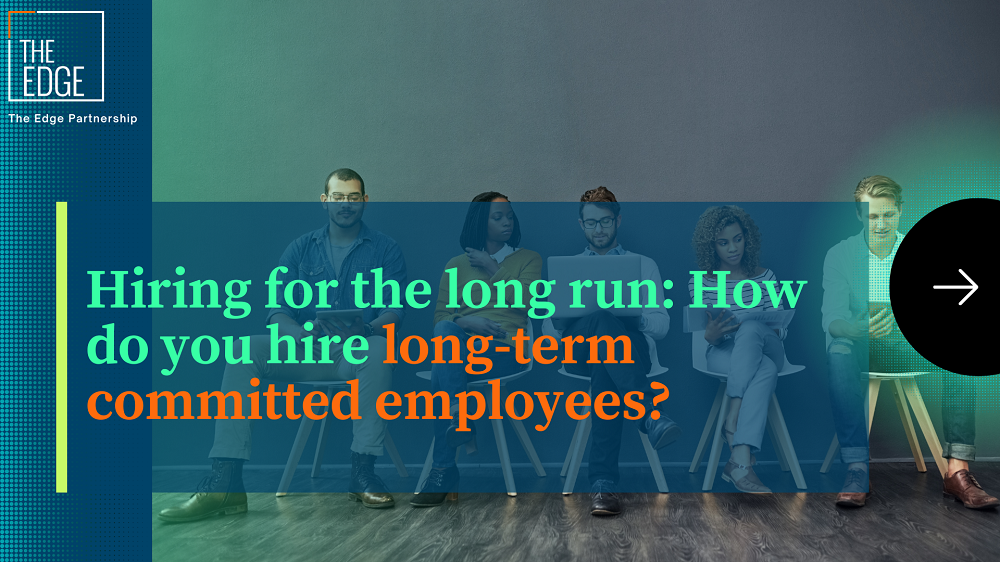
Hiring For The Long Run: How Do You Hire Long-Term Committed Employees?
October 2023

October 2023
The modern work landscape is constantly changing. A noticeable trend has emerged with employees frequently transitioning between roles, presenting significant recruitment and onboarding challenges for employers.
But there’s also other reasons: the rapid proliferation of the gig economy and the allure of multifaceted experiences have further compounded the complexities of talent retention.
Amid these shifting parts, there exists a group of individuals actively seeking job stability and a lasting professional journey – a promising talent pool that requires skillful identification and engagement.
According to LinkedIn 2023 hiring trends report, LinkedIn data shows that employees stay at companies almost 2x longer if the employer is highly committed to their career progression.
Gallup research has also shown that being engaged at work increases retention. This most recent study further confirms: Actively disengaged employees are three times more likely than engaged employees to be watching or actively looking for job opportunities.
As the demand for talents continues, here are some strategies businesses can leverage to ensure they’re selecting candidates who are in for the long run.
1. Cultivate a retention-focused environment
A proactive approach to improving retention involves creating an environment that nurtures it. Often, job dissatisfaction results from issues like company culture or undefined career paths. Regularly engage with potential and existing employees to understand their priorities and address areas of discontent, a key strategy in retaining top talent
2. Providing tangible benefits
Encouraging candidates to commit for the long term can be achieved by linking their tenure to tangible benefits such as stock options, special bonuses, educational opportunities for leadership roles, and more. The key is to align these benefits with the candidate’s time spent with the company while considering their contributions.
3. Have quarterly check-ins
Having quarterly check-ins such as “Where do you see yourself in five years?” and “Why do you want this role?” can yield valuable insights into a candidate’s mindset and aspirations. Some candidates may subtly convey that they view the role as a stepping stone rather than a cornerstone in their career. Paying attention to such cues is crucial in identifying candidates interested in long-term commitment.
4. Evaluate for cultural fit
Assessing culture fit during interviews helps gauge a candidate’s alignment with the organisation’s values, beliefs, and behaviours. This approach ensures compatibility with the company’s work environment and long-term goals, ensuring candidates seek a lasting career, not just another job. Incorporating behavioural questions and involving multiple team members in interviews are effective methods to gauge culture fit.
5. Offer flexible work options
Work-life balance is a common reason for frequent job changes. Embracing a flexible work culture not only attracts top talent but also fosters loyalty among current employees. This approach helps in recruiting individuals seeking permanent employment opportunities
6. Identify industry interest
To reduce the risk of hiring job hoppers, probe candidates about their interest in your industry and business. Ask questions that reveal their enthusiasm and energy for the industry and inquire about their aspirations for the future. Passionate candidates are more likely to stay with your organisation.
7. Highlight growth opportunities
During the hiring process, align potential career paths with candidates’ long-term goals. Prioritise mentorship programs and emphasise skill growth and professional development opportunities. Transparently communicate these prospects and complement them with an appealing benefits package to enhance retention efforts.
8. Clear reporting structures
Reporting structure is an often overlooked aspect in discussions. Understanding how the internal structure of an organisation works provides candidates with insights into their position within the organizational framework. This clarity empowers candidates to assess the role’s growth trajectory and determine its compatibility with their long-term career objectives.
Knowing that one in four employees is currently being recruited by the competition companies, there is a need to remind people why they joined in the first place.
Consider what is most appealing about the organisation and what sets it apart. By highlighting those values, attributes and offerings, you can ensure their experience of working at the organisation is aligned with the purpose and culture communicated by leadership.
Want to find committed and long-term employees? Connect with The Edge Partnership today and let us assist you in discovering committed, long-term employees who will drive your company’s success.